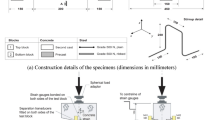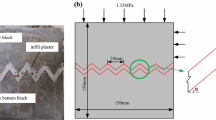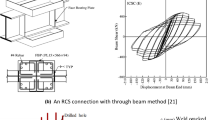Abstract
In this study, the effect of low normal stress levels on shear behavior of jointed samples was investigated using discrete element method (DEM). Based on the experimental design, 50 jointed samples with different joint persistency (JP) were modeled under low normal loads. The results of numerical modeling showed that the effectiveness of the normal load is greater in the post-peak and enters operation after the failure point. Moreover, increasing the normal stress on the shear surface changes the behavior from brittle to ductile. Standard deviations of shear strengths showed that changes in normal stress at higher JP have less effect on the shear strength of jointed samples. Also, for a constant JP, the shear stiffness of the sample increases with normal stress, and increasing the JP does not have a significant effect on the shear stiffness of the sample. Increase in JP at a constant normal stress level decreases the sample dilation. Considering the crack formation in a constant JP, it was observed that up to the peak shear stress, the number of cracks increases with increasing the normal stress, and this is not continuous after the peak and shows different variations. The results showed that with decreasing the JP, the relative growth of cracks in the vertical direction decreased and more cracks were created in the direction of the shear plane. The propagation and coalescence of cracks and the creation of a failure surface can also cause stress relaxation, and the magnitude of the contact force between the particles depends on this issue.























Similar content being viewed by others
References
Bahaaddini M (2017) Effect of boundary condition on the shear behaviour of rock joints in the direct shear test. Rock Mech Rock Eng 50:1141–1155
Bahaaddini M, Hagan P, Mitra R, Hebblewhite B (2016) Numerical study of the mechanical behavior of nonpersistent jointed rock masses. Int J Geomech 16:04015035
Bahaaddini M, Sharrock G, Hebblewhite B (2011) A comparison of physical and numerical experiments on artificial jointed rock masses using PFC3D. In: Proceedings of the 2nd International FLAC/DEM Symposium, Melbourne, Australia
Bahaaddini M, Sharrock G, Hebblewhite B (2013a) Numerical direct shear tests to model the shear behaviour of rock joints. Comput Geotech 51:101–115
Bahaaddini M, Sharrock G, Hebblewhite B (2013b) Numerical investigation of the effect of joint geometrical parameters on the mechanical properties of a non-persistent jointed rock mass under uniaxial compression. Comput Geotech 49:206–225
Boulon M, Armand G, Hoteit N, Divoux P (2002) Experimental investigations and modelling of shearing of calcite healed discontinuities of granodiorite under typical stresses. Eng Geol 64:117–133
Brown ET (1981) Rock characterization, testing & monitoring: ISRM Suggested Methods
Eberhardt E, Kaiser PK, Stead D (2002) Numerical analysis of progressive failure in natural rock slopes. In: ISRM International Symposium-EUROCK 2002. International Society for Rock Mechanics
Einstein H, Veneziano D, Baecher G et al (1983) The effect of discontinuity persistence on rock slope stability. In: International journal of rock mechanics and mining sciences & geomechanics abstracts. Elsevier 5:227–236
Elmo D, Clayton C, Rogers S et al (2011) Numerical simulations of potential rock bridge failure within a naturally fractured rock mass. In: Proceedings International Symposium on Rock Slope Stability in Open Pit Mining and Civil Engineering (Slope Stability 2011). pp 18–21
Ge Y, Tang H, Ez Eldin M et al (2017) Evolution process of natural rock joint roughness during direct shear tests. Int J Geomech 17:E4016013
Ghazvinian A, Nikudel M, Sarfarazi V (2007) Effect of rock bridge continuity and area on shear behavior of joints. In: The Second Half Century of Rock Mechanics, Three Volume Set: 11th Congress of the International Society for Rock Mechanics. p 247
Grasselli G (2001) Shear strength of rock joints based on quantified surface description. EPFL
Hencher S (2014) Characterizing discontinuities in naturally fractured outcrop analogues and rock core: the need to consider fracture development over geological time. Geol Soc Lond Spec Publ 374:113–123
Hencher S, Lee S, Carter T et al (2011) Sheeting joints: characterisation, shear strength and engineering. Rock Mech Rock Eng 44:1–22
Hoek E (2007) Practical rock engineering. Set of course notes. Shear strength of discontinuities
Hossaini KA, Babanouri N, Nasab SK (2014) The influence of asperity deformability on the mechanical behavior of rock joints. Int J Rock Mech Min Sci 70:154–161
Inc. ICG (2008) PFC2D Manual
ISRM (1978) Suggestedmethods for the quantitative description of discontinuities in rock masses, International Journal of Rock Mechanics and Mining Sciences & Geomechanics Abstracts:319–368
Jade S, Sitharam T (2003) Characterization of strength and deformation of jointed rock mass based on statistical analysis. Int J Geomech 3:43–54
Jennings JA (1970) Mathematical theory for the calculation of the stability of slopes in open cast mines. Planning Open Pit Mines, Proceedings, Johannesburg 2:87–102
Jiang M, Liu J, Crosta GB et al (2017) DEM analysis of the effect of joint geometry on the shear behavior of rocks. Comptes Rendus Mécanique 345:779–796
Kemeny J (2005) Time-dependent drift degradation due to the progressive failure of rock bridges along discontinuities. Int J Rock Mech Min Sci 42:35–46. https://doi.org/10.1016/j.ijrmms.2004.07.001
Kulatilake P, Malama B, Wang J (2001) Physical and particle flow modeling of jointed rock block behavior under uniaxial loading. Int J Rock Mech Min Sci 38:641–657
Lajtai E (1969) Strength of discontinuous rocks in direct shear. Geotechnique 19:218–233
Liu Y, Dai F, Fan P et al (2017) Experimental investigation of the influence of joint geometric configurations on the mechanical properties of intermittent jointed rock models under cyclic uniaxial compression. Rock Mech Rock Eng 50:1453–1471
Mahabadi O, Lisjak A, Munjiza A et al (2012) Y-Geo: new combined finite-discrete element numerical code for geomechanical applications. Int J Geomech 12:676–688
Mas Ivars D, Pierce ME, Darcel C et al (2011) The synthetic rock mass approach for jointed rock mass modelling. Int J Rock Mech Min Sci 48:219–244. https://doi.org/10.1016/j.ijrmms.2010.11.014
Mehranpour MH, Kulatilake PH (2017) Improvements for the smooth joint contact model of the particle flow code and its applications. Comput Geotech 87:163–177
Meng F, Song J, Yue Z et al (2022) Failure mechanisms and damage evolution of hard rock joints under high stress: Insights from PFC2D modeling. Eng Anal Boundary Elem 135:394–411. https://doi.org/10.1016/j.enganabound.2021.12.007
Nguyen V-M, Konietzky H, Frühwirt T (2014) New methodology to characterize shear behavior of joints by combination of direct shear box testing and numerical simulations. Geotech Geol Eng 32:829–846
O'Reilly KJ (1980) The effect of joint plane persistence on rock slope reliability. M.Sc. thesis, Massachusetts Institute of Technology
Park J-W, Song J-J (2009) Numerical simulation of a direct shear test on a rock joint using a bonded-particle model. Int J Rock Mech Min Sci 46:1315–1328
Potyondy DO (2015) The bonded-particle model as a tool for rock mechanics research and application: current trends and future directions. Geosystem Engineering 18:1–28
Potyondy DO, Cundall P (2004) A bonded-particle model for rock. Int J Rock Mech Min Sci 41:1329–1364
Seidel JP, Haberfield CM (2002) A theoretical model for rock joints subjected to constant normal stiffness direct shear. Int J Rock Mech Min Sci 39:539–553
Shang J, Hencher SR, West LJ (2016) Tensile strength of geological discontinuities including incipient bedding, rock joints and mineral veins. Rock Mech Rock Eng 49:4213–4225. https://doi.org/10.1007/s00603-016-1041-x
Shang J, Zhao Z, Hu J et al (2018a) 3D particle-based DEM investigation into the shear behaviour of incipient rock joints with various geometries of rock bridges. Rock Mech Rock Eng 51:3563–3584
Shang J, Zhao Z, Ma S (2018b) On the shear failure of incipient rock discontinuities under CNL and CNS boundary conditions: insights from DEM modelling. Eng Geol 234:153–166
Stead D, Eberhardt E (2013) Understanding the mechanics of large landslides. Ital J Eng Geol Environ Book Ser 6:85–112
Tang P, Chen G-Q, Huang R-Q et al (2021) Effect of the number of coplanar rock bridges on the shear strength and stability of slopes with the same discontinuity persistence. Bull Eng Geol Env 80:3675–3691
Tuckey Z, Paul J, Price J (2016) Discontinuity survey and brittle fracture characterisation in open pit slopes using photogrammetry. In: Proceedings of the First Asia Pacific Slope Stability in Mining Conference. Australian Centre for Geomechanics, pp 587–600
Ulusay R, Hudson J (2007) The complete ISRM suggested methods for rock characterization, testing and monitoring: 1974–2006, Commission on testing methods International Society of Rock Mechanics Compilation arranged by the ISRM Turkish National Group, Ankara, Turkey 628
Wang T-T, Huang T-H (2009) A constitutive model for the deformation of a rock mass containing sets of ubiquitous joints. Int J Rock Mech Min Sci 46:521–530
Yang X-X, Kulatilake PH (2019) Laboratory investigation of mechanical behavior of granite samples containing discontinuous joints through direct shear tests. Arab J Geosci 12:79
Zare S, Karimi-Nasab S, Jalalifar H (2021) Analysis and determination of the behavioral mechanism of rock bridges using experimental and numerical modeling of non-persistent rock joints. Int J Rock Mech Min Sci 141:104714. https://doi.org/10.1016/j.ijrmms.2021.104714
Zhang H, Zhao Z, Tang C et al (2006) Numerical study of shear behavior of intermittent rock joints with different geometrical parameters. Int J Rock Mech Min Sci 43:802–816
Zhang Y, Jiang Y, Asahina D et al (2020) Experimental and numerical investigation on shear failure behavior of rock-like samples containing multiple non-persistent joints. Rock Mech Rock Eng 53:4717–4744
Acknowledgements
The authors wish to express their thanks to the Kashigar Geomechanics Research Center (KGMC).
Author information
Authors and Affiliations
Corresponding author
Ethics declarations
Competing interest
The authors declare no competing interests.
Rights and permissions
Springer Nature or its licensor (e.g. a society or other partner) holds exclusive rights to this article under a publishing agreement with the author(s) or other rightsholder(s); author self-archiving of the accepted manuscript version of this article is solely governed by the terms of such publishing agreement and applicable law.
About this article
Cite this article
Zare, S., Karimi-Nasab, S. & Jalalifar, H. Evaluation of the effect of low normal stresses on the joint shear behavior using numerical simulation. Bull Eng Geol Environ 81, 516 (2022). https://doi.org/10.1007/s10064-022-03004-3
Received:
Accepted:
Published:
DOI: https://doi.org/10.1007/s10064-022-03004-3




